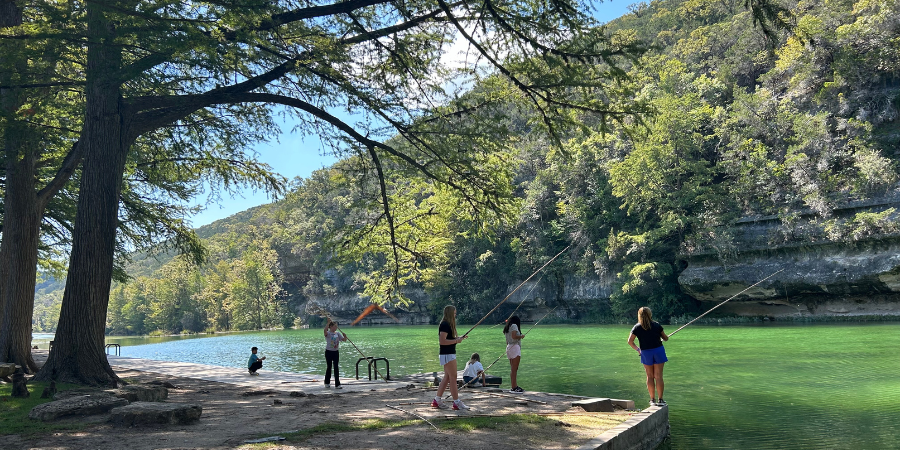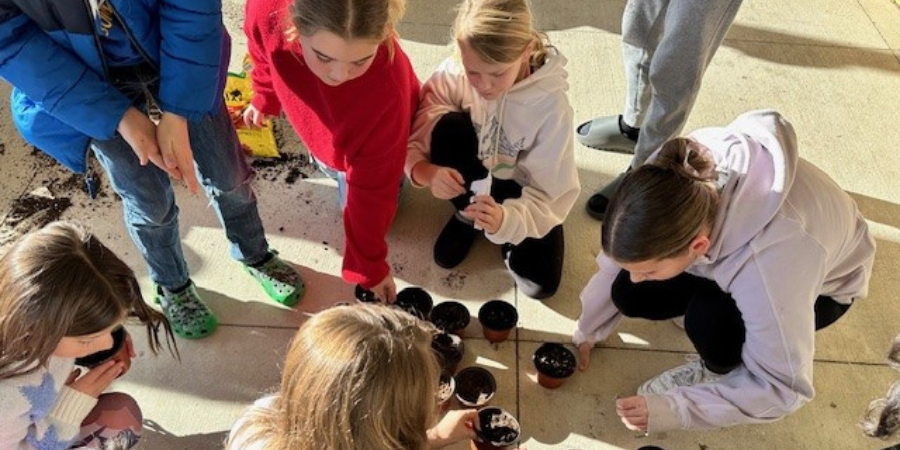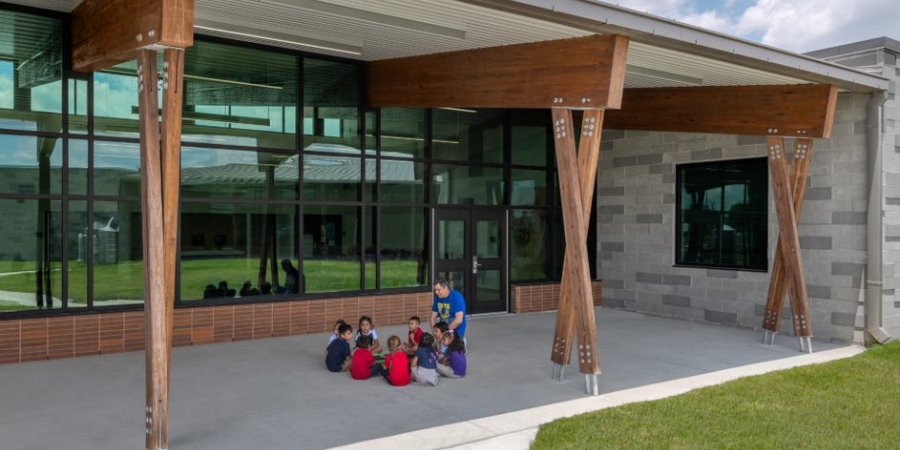Schools Take Learning to the Great Outdoors

Rosa Ledesma guides the Kerrville ISD sixth graders down a shaded dirt path next to the sparkling Frio River, encouraging them to use all their senses to absorb the natural surroundings.
“I smelled the river,” one exclaimed when Ledesma asked what they experienced. “The wind felt cool on my face,” another replied. “I saw birds!” Some kids then stretched out beside the cool waters of the Frio and others relaxed on flat rocks as Ledesma talked about getting immersed in nature.
The natural setting served as an important teaching aid. “At that age, most kids are navigating school pressures, social dynamics, and a lot of change, so through my activity I tried to show them how nature can serve as a tool for relaxation, emotional balance, and a mechanism for coping with stress,” said Ledesma, assistant director of Kerrville's Parks and Recreation Department.
The young nature explorers were participating in Kerrville ISD’s annual Outdoor Education program, an overnight camping trip held each fall that is open to all sixth-grade students. About 275 of the district’s 325-350 sixth graders attend every year.
“Over 50% of Kerrville ISD students are economically disadvantaged, and most have not experienced an overnight away from home, so this is quite a unique and memorable experience for them,” said TASB President Rolinda Schmidt, a Kerrville ISD trustee. “It’s a perfect setting for students and teachers to experience camp life deep in the Texas Hill Country and bond in a nontraditional school setting.”
Campers learn from experts in the fields of forestry, animal tracking, water and soil conservation, and entomology, said Schmidt, a longtime camp volunteer who teaches a knot-tying skill called lacing. Games, rock painting, fishing, and other activities round out the experience. They stay in groups in cabins.
The Kerrville ISD program aims to build students’ connections with fellow classmates, teachers, parents, and community members while also fostering “a love of learning outside the school walls,” said Krista Thorpe, a sixth-grade teacher and the program’s lead coordinator.
Community members volunteer to share their knowledge and experiences with students and help them develop career ideas and build support for skills they are learning at school. “Students give back by learning responsibility, citizenship, and service to others through activities and carry that back after the trip,” Thorpe said.
While immense fun for the kids, the camp experience is a labor-intensive effort that requires the support of district staff as well as community sponsors, program presenters, and parent volunteers. But they, like so many educators across Texas, understand that getting students engaged in outdoor learning is worth it.
Getting off technology and outside the traditional four-wall classroom opens up interesting ways to learn. Observing a butterfly’s life cycle offers valuable science lessons. Setting up a school garden can boost problem-solving skills. Time outside also reduces screen time, offers physical and mental benefits, fuels creativity, builds confidence, and improves social skills.
“Any access to nature is good. Any chance to go outside is beneficial,” said Melissa Turnbaugh, a senior principal for education and innovation at PBK Architects in Houston. She designs schools with nature in mind and has worked on projects at Alief and Round Rock ISDs, among others.
Outdoor Learning Environments
Set in the stunning Hill Country, Kerrville ISD may have easier access to the great outdoors. But school leaders and educators in urban, suburban, and rural public schools across Texas are finding interesting ways to incorporate nature and the outdoors into learning activities:
• San Antonio ISD’s Advanced Learning Academy boasts an active garden program involving many teachers. At another SAISD school, students worked to transform an 11,000-square foot grassy courtyard at Collins Garden Elementary School into a monarch butterfly and pollinator garden.
• Alief ISD’s Jefferson Early Learning Center has an outdoor learning space for students that includes Texas ecology-themed trails with native grasses, plants, and trees. The surrounding community also has some access to the learning trails.
• Seguin ISD recently acquired the Irma Lewis Outdoor Learning Center and is using the 129-acre nature site as a focal point to further develop its outdoor education efforts. The center also recently hosted a leadership summit to discuss the importance of outdoor education. School leaders and educators gathered at the center in February to discover ways to better implement outdoor learning in their schools.

At Sunnyvale ISD’s Intermediate School in the Dallas area, budding agriculture scientists incubate chicken eggs and grow plants in different systems as part of a multidisciplinary school project that culminates in a student-run Garden Market for the community.
“We will sell these plants in our farmer’s market along with salsa and chicks that have been hatched in classrooms throughout our school,” said fifth-grade math teacher Lisa Stovall, who also runs the Junior Future Farmers of America program for students in third through fifth grade.
Science lessons are fairly easy to establish. To discover how different types of sunlight and weather affect growth, gardens and plants in pots are cultivated at spots around campus. Chicks are incubated in several classrooms, allowing students to learn the life cycle. A chicken coop was built outdoors near the playground for the chicks.
Using nature to teach math has to be more intentional, Stovall said. “I use probability with the chickens and then we measure, predict, and graph plant growth.” A financial literacy aspect to the project evolves around discussions about prices for plants and chicks and calculating profits from the market. At last year’s market, the students made $400, which goes back into the project’s account.
“My biggest goal for this project is to get kids outside and for them to learn where their food comes from! I want them to know how hard it is to raise crops and animals and to understand all that is involved with plants growing from seed to table,” Stovall said. “I think our kids have disconnected from the world and spend way too much time on screens. I want them to be involved in outside activities and learn about our environment.”
Linda Gooch, vice president of the Sunnyvale ISD school board and a TASB Director, credits Stovall for doing “an incredible job of making learning not only incredibly relevant but really fun for students.
“She has taken typical math lessons and created a truly memorable experience for our kids,” Gooch said. “They will never forget getting the hands-on, outdoor learning adventure of raising their chicks, planting their gardens, building their garden beds, and then hosting a community Garden Market — all while learning math!”
Growing the Program
As the plants grow, so has the junior FFA program. A few outdoor garden beds were established last year. A butterfly garden with multiple habitats around school was added this year.
Stovall launched the project eight years ago with 50 students and now has 110 in the current class. A cut-off number had to be established. Most of the participating students have never been involved in farming or raising livestock before. “The kids learn so much and love helping with the plants and chickens inside and out in the coop by our playground,” Stovall said. “When kids learn hands-on, they never forget the concepts taught. Making learning fun and exciting makes students want to be at school.”
Bringing Nature Inside
Research shows other potential benefits to outdoor education, including improved focus for kids when they return to the classroom. And bringing the outdoors inside, through the use of natural lighting, interior plants, and use of natural materials, also can be beneficial for learning and students’ overall well-being.
Round Rock ISD’s Redbud Elementary School, for example, uses natural light and materials and colors to help create a nature-like feel inside the school. Turnbaugh, the architect, said providing a more natural interior in schools can be calming and restorative for students — and teachers and staff.

Alief ISD’s Jefferson Early Learning Center, which opened in southwest Houston in August 2022, was designed to instill a deep appreciation for nature in a dense, urban setting in a largely disadvantaged community where concrete often prevails.
Located on about 20 acres, the property’s perimeter was designed to model the area’s natural habitats: wetlands, prairie areas, forest, and backyards. Using a spiral design found in nature, the outdoor area has six large covered back porches and four backyard spaces equipped with working cisterns used to irrigate plants. Students use child-size watering cans, gloves, wheelbarrows, and other tools donated to the effort. Additionally, community residents can walk some trails, and the district has had community events such as tree planting and wildflower seeding.
Indoors, textured and colorful materials are used along the corridor walls. Big windows offer views of nature. Themed learning environments reflect the region and include a space-themed classroom, and one highlighting the ecosystems and wildlife native to the region.
“We know young children learn best through hands-on authentic experiences. Our indoor and outdoor learning is seamless by design,” said Kimberly Hammer, principal of the school of nearly 400 students. “It’s a joy to watch the children play in the grass, smell the flowers, and watch birds and butterflies as part of their daily routine. At Jefferson, we love to learn — both indoors and outdoors!”
The Alief ISD board was very supportive of the overall project and its long-term vision for the school and community, said Turnbaugh, the architect. Darlene Breaux, Alief ISD board president and a TASB Director, said the center “is a shining example of how our district is committed to nurturing the whole child. By providing rich outdoor learning opportunities, we are not only enhancing early childhood education but also creating spaces that benefit the entire community.
“I am so proud that Jefferson Early Learning Center is giving our youngest learners, their families, and our community a place to learn, explore, and grow through outdoor experiences! These opportunities go beyond the classroom — they spark curiosity, creativity, and a love for learning that lasts a lifetime,” Breaux said. “As Board President and a TASB Director, it means so much to see our kids thriving in a space where they can connect with nature, ask big questions, and discover the world around them.”
Gardens Galore in San Antonio
An active garden program involving passionate teachers is popular at San Antonio ISD’s Advanced Learning Academy. Students tend to different types of garden areas across the campus, including a vegetable garden and an outdoor learning center with native plants. Family workdays are scheduled twice a year.
A privately sponsored program, Blooming with Birdie’s Caterpillar Condos for Classrooms, placed 265 condo kits in San Antonio ISD classrooms last fall to provide a hands-on, TEKS-aligned curriculum. During the six-week program, students maintain the habitats, observing and learning about the life cycle of the brilliant black-and-orange winged insects.
Participants in the program, which is in its fifth year and involves other San Antonio-area districts, are encouraged to attend the free Monarch Butterfly and Pollinator Festival in San Antonio, said Cheri Tondre, a gifted-and-talented education instructional specialist in the district.
“I work on a number of nature-based projects,” Tondre said. “I am passionate about creating opportunities for students to explore their interests and engage with real-world issues.”
A decade ago, with the help of a local grant, Tondre and her students turned an unkempt courtyard at Collins Garden Elementary School into a monarch butterfly and pollinator garden. The school will undergo a redesign, and the garden will be the center of the metamorphosis, she said.
Student, Teacher, Mother
Last fall’s trip for Kerrville ISD students at the H.E. Butt Foundation Camp marked the first time Ledesma was a presenter.
“Participating in this program has been a long-time goal of mine, so having the opportunity to contribute was very fulfilling on a personal and professional level,” said Ledesma, who attended the camp years ago as a Kerrville ISD student.
“Outdoor Education as a sixth grader was an amazing experience. I still remember collecting water samples with UGRA [Upper Guadalupe River Authority], lacing, and fishing,” she recalled. “It taught me a lot about the river, ways to be active in nature, and opened my eyes to how lucky we were to live in a community that had ‘wilderness’ in its backyard.”
Her camping adventure sparked a lasting interest in nature and creating spaces and programs outdoors that benefit her community. “It inspired me to pursue a career in parks and recreation, where the goal is to improve the quality of life for community members by providing access to nature, along with high-quality programs and services.”
And in a couple of years, Ledesma plans for her son Emmitt to join her at camp when he’s in sixth grade.
“I look forward to bringing him along and introducing him to the experiences that shaped me,” said the proud mom and outdoor enthusiast. “It’s going to be an unforgettable opportunity.”
Laura Tolley
Laura Tolley is the managing editor of Texas Lone Star.




